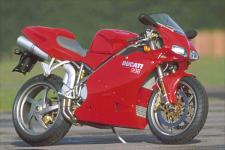2002 Ducati 998 - Motorcycle.com
Silverstone-shire-derby-flamoozle, England, 12 January 2002
Unbelievably, the 916 has been around since 1994. That's way back in the time when Yamaha's FZR1000 was still the big dog in the show rooms.
When released, the 916 didn't revolutionize the sport bike sector, Honda had already done that with their Fireblade. What it did, however, is put that new definition of performance into perhaps the prettiest package of the decade. The 916 is still with us and it looks much the same as it did back in '94. Most people generally agree that, almost ten years later, it looks up-to-date. The Ducati has enjoyed gradual updates year by year, and is still arguably at the top of its class.
Now that the history lesson's over, what's it like to ride? In a word, brilliant!
Yes, that's it - BRILLIANT!
At this point I could save this file and end my report - anything said from now on is simply a variation of brilliant. But, OK, you probably haven't ridden the bike so I'll be sensible and run through this test from start to finish, starting with the engine.
This year, the entire 916 - sorry, it's now the 998 range - benefits from the new Testastretta, or narrow head engine. This is the motor Troy Bayliss used to win the World Superbike title this year. It comes in three states of tune: 123 bhp for the 998, 136 for the 998S and a claimed 139 bhp for the limited edition customer racer, the 998R. The engine actually displaces 998ccs - hence the name!
On the track, it's immediately apparent that in its latest guise, the engine is much more responsive low down than in previous incarnations. The standard 998 is still a little short of puff on top, a GSX-R1000 would laugh at its straight-line performance, but the stronger 139bhp 998R might silence the Suzuki's chuckles. Torrents of torque make the bike very easy to ride. Even if you ham up the gears and exit a corner too far up the six-speed box, the bike will rescue you, pulling strongly from as low as 2,000rpm. It'll pull from below that, but the power pulses from the two 500cc pistons swinging up and down in the 90-degree V create too much snatch in the drive train for anyone with mechanical sensitivities to try it for long.
The power's build-up is linear and there's no sudden power band to catch you out, but there is enough low-down grunt to break the rear tire's traction in the damp or cold conditions that were prevalent during my track test at Silverstone. Early in the morning, when damp patches still littered many of the corners, I lit up the rear tire, sliding it full sideways as I exited a tight turn. It was a progressive slide and the bike kept itself in order as I rolled off the throttle gently. Thankfully, the rear hooked up again without drama when I got back on the power. There wasn't even a hint of high side.
A powerful engine is all very well, but it needs a capable chassis to help get the power promised by that glorious V-Twin onto the ground and to keep it there. This is an area that the 916 series has always excelled in and this year is no different. While the standard 998 isn't as exotically equipped as its 998R stablemate, it's nonetheless plenty well equipped to cope with the 123 bhp on tap. The Brembo brakes are also a notch down from the trick race parts fitted to the R, but again, the bike stops without drama and without a great deal of effort at the lever.
Entering the turns at the end of both the fast front and back straights at Silverstone gave them a good test, which they passed with flying colors by providing consistent and dependable braking time and time again. There was no fade, no excess lever travel, no hint of sponginess - just plenty of progressive two-fingered braking power all day. Compare that to the disappointing feel of the early 916 brakes, and there's even more evidence that the 916 is evolving well.
More by Glenn le santo































Comments
Join the conversation